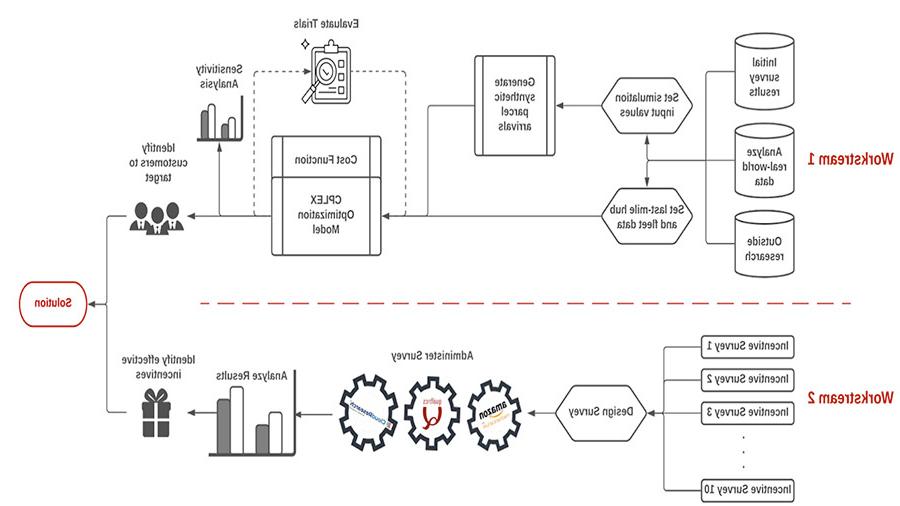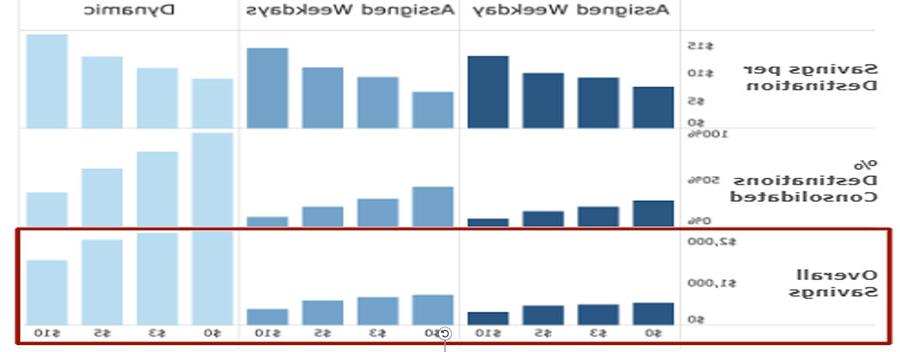Parcel Consolidation in Last-Mile Delivery, Sponsored by Tata Consultancy Services
A Tepper School MSBA Capstone Project
Parcel delivery companies (i.e., United Parcel Service, FedEx, Amazon) are challenged with an intricately complex logistical problem - moving parcels from origin to destination as efficiently as possible. The final leg of delivery logistics is last-mile delivery. For customers with relatively frequent orders, multiple parcels are likely to pass through the same last mile over a short time frame.
We explore an approach to achieve cost savings through the implementation of a parcel consolidation program. We introduce a framework to target the most valuable customers and compare customer-facing incentives to motivate program participation.
Our experiments have shown that parcel consolidation schemes are an effective way to reduce last-mile costs. Specifically, given enough capacity to store held parcels overnight at the last-mile hub, the marginal stop costs saved outweigh the parcel storage costs. Dynamic parcel consolidation has the highest savings, but is not feasible to implement in real-life.
Two days per week assigned delivery days has higher savings compared to single day of week assigned delivery, due to the fact that more destinations can be included in the program under the two days per week delivery scheme.
Last-Mile Delivery Is Critical
The last-mile delivery cost function is complicated and depends on many parameters such as transportation hub's fixed and variable costs of truck, fuel, distance traveled, time duration, parcel weight, and volume. Due to confidentiality and a competitive market, major parcel carriers’ actual last-mile delivery cost function is not available publicly. Gevaers, et al. (2014) modeled total last-mile costs by modeling specific last-mile characteristics as independent variables.
In our simplified version, we have referenced two sources to derive cost per delivery stop from quarterly earnings reports of parcel carriers (UPS and FedEx) and the annual ATRI (American Transportation Research Institute) report provides transportation cost per hour and transportation cost per mile. These studies suggest an average last-mile delivery cost per stop of about $4.50, which is the number we use in our optimization model.

Key Questions/Hypothesis
- Parcel consolidation beyond promised delivery date reduces last-mile delivery costs.
- There are incentives that motivate customers to opt-in for delayed parcel delivery.

Framework Architecture
We set forth a dual-workstream framework to evaluate our hypotheses. Workstream 1 aims to identify customers (destinations) to target for participation in consolidation programs. Workstream 2 aims to identify effective incentives for convincing customers to opt-in for participation in consolidation programs.
In the diagram, we highlight the framework components that make up each workstream. Together, Workstream 1 and Workstream 2 form a framework that may be repeatedly employed by a parcel carrier to model and evaluate different real-world scenarios. By identifying the customers to target, and identifying what incentives are most effective, a parcel carrier may develop a strong consolidation program that will result in optimal operations savings.

Parcel Consolidation Does Improve Cost Savings
A key component of our analysis is the mixed integer linear programming model built and solved using the DOCPLEX solver. The optimization model simulates the impact of our various consolidation strategies, with the primary benefit of identifying the destinations to target for consolidation which save the most costs, subject to our various constraints.
Our experiments have shown that parcel consolidation schemes are an effective way to reduce last-mile costs. Specifically, given enough capacity to store held parcels overnight at the last-mile hub, the marginal stop costs saved outweigh the parcel storage costs. Dynamic parcel consolidation has the highest savings, but is not feasible to implement in real-life. Two days per week assigned delivery days has higher savings compared to single day of week assigned delivery, due to the fact that more destinations can be included in the program under the two days per week delivery scheme.

Survey Respondents Preferred Gift Card
Incentive surveys reveal that parcel consolidation programs are viewed favorably by consumers. Roughly two-thirds of respondents indicated that they would participate in the two days per week fixed delivery model for no monetary incentive at all, though different monetary incentives increase the reported participation rate. Consumers prefer the two fixed days per week scheme over the dynamic scheme.
Given the willingness to participate in a consolidation program and the potential for cost savings, we recommend that parcel carriers implement a consolidation pilot program at key last-mile hubs without offering incentives for participation. In preparation for a pilot program, the framework described in this report can be applied to a real-last mile hub to reveal the optimal consolidation scheme, expected cost savings, and willingness to enroll in the program.


